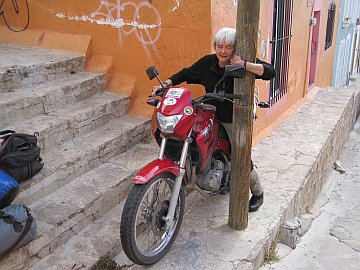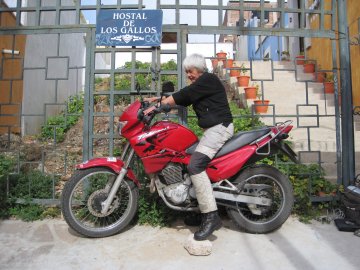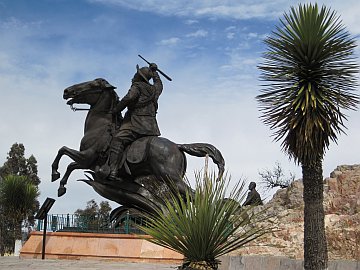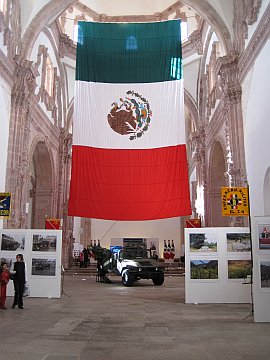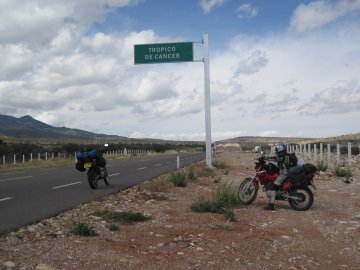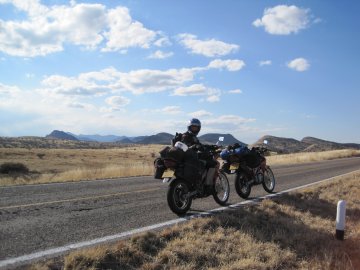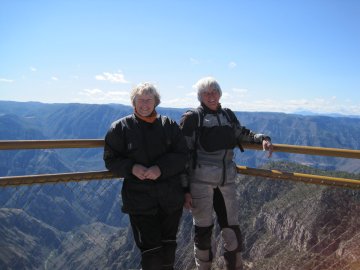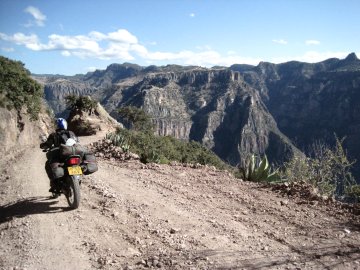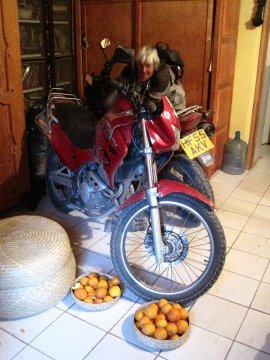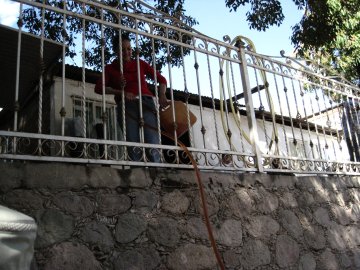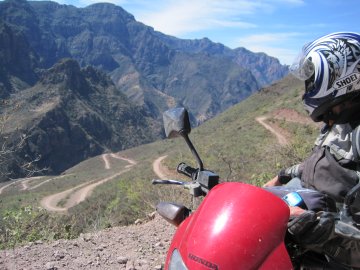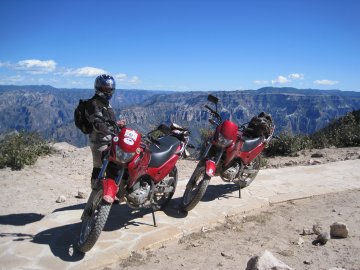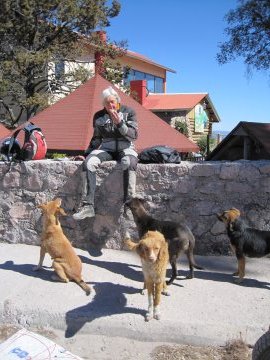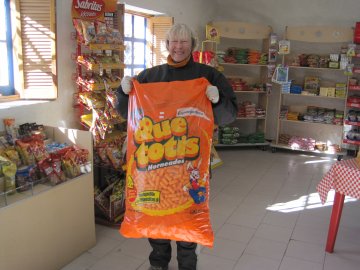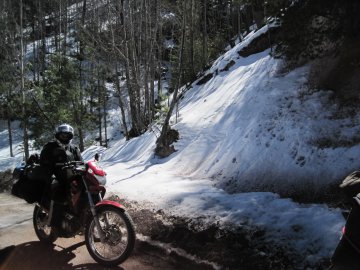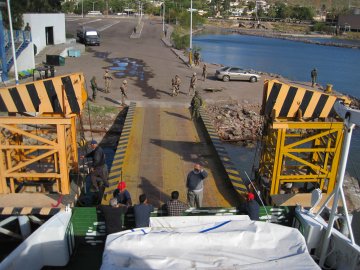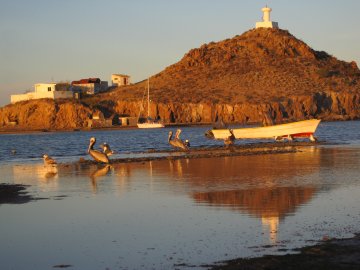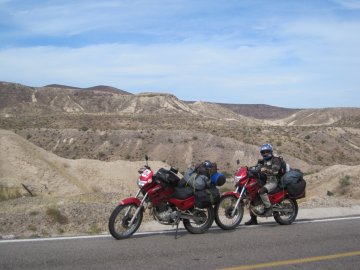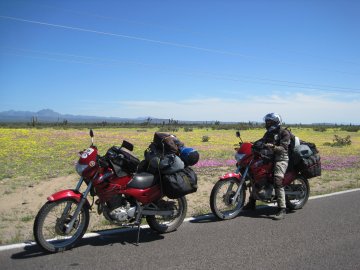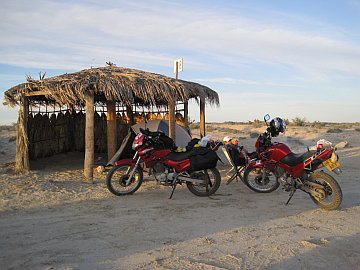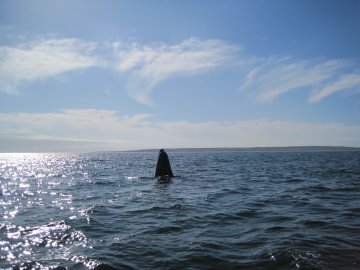Mexico Part 2
Back to reality and heading north over more mountains, we got to Zacatecas which was very full. Nightmare finding somewhere to stay, but we eventually defeated the one way system and ended up at the delightful Hostel de los Gallos at the top end of a steep cul de sac parking was interesting. Pat had to chain her bike sideways onto a wrought iron fence and stick a large rock under her sidestand. Mine was chained to a telegraph pole on a narrow ledge. Pepe, the new young owner plans to organize parking in the near future...
Pat's got it in how the hell's she going to get it out and what about her own bike?
it's here somewhat precariously stashed. She's hanging onto the fence wih her right hand.
Zacatecas is another silver-mining town. Now closed and a tourist attraction, the Eden mine is huge and accessed by a little train. Health and safety rule here with hard hats, proper walkways, unlike the one at Potosi in Bolivia where we took dynamite and fuses as presents for the miners and crawled along dust-filled tunnels within earshot of blasting
.
It also has an underground disco, so presumably no complaints from the neighbours.
Zacatecas also boasts a Swiss cable car traversing the town from one hill to another and huge equestrian statues of Mexican hero Pancho Villa and his compatriots, all of whom came to sticky ends. We were surprised to see a full-on military exhibition within the soaring confines of a beautiful old church.
Pancho Villa
You can join the army and the air force here. Women welcome.
Onwards and northwards towards our goal of the Barranca del Cobre, or Copper Canyon.
the bikes have now crossed both Tropics, the Equator and the Arctic Circle and been to Ushuaia.
wide open road
Days of very cold, windy riding across endless plains till we arrived at the dusty wild-west town of Guayacochi, a 30km dirt ride from the stunning Sinforoso Canyon. The Tarahumaras indigenous locals are famous for their long distance running prowess in bare feet.and have done phenomenally well in endurance events worldwide. Many foreigners also come to compete in a long distance mountain race with them to the bottom of the Canyon and back.
We have no intention of even walking down there
Tarahumara boys note local dress
Our best days riding on the whole trip so far was down a dirt road into the Canyon de Batopilas down to the town of the same name the 40km trip took us 3 hours and was a lot more challenging than the Worlds Most Dangerous Road in Bolivia, but fortunately with far less traffic. The drops off the edge were not a kilometre this time, but after the first hundred metres, who cares?
At the bottom was the warm (gorgeous after so many freezing cold weeks) and sunlit little mining town of Batopilas where we basked for a couple of days in sub-tropical temperatures, and did a bit of exploring.
They grow oranges and other subtropical fruit at the bottom of the Canyon
Petrol station in Batopilas.
Back up the same road, stopping for yet more photographs
It seemed easier on the way up
Final canyon view from Divisidero.
Pat has a bite of lunch in Divisidero
Creel: Sho's picnic choice
to Creel considered to be the gateway to the Canyons and to a hostel with heating in our room what bliss! Met lots of interesting travelers here including an American couple with 20 BMW bikes in their garage. Seems he just couldnt get rid of them when he bought the next one.
We thought it was cold this confirmed it
We dithered here about where to go next, but finally plumped for Baja California to go whale watching. It finally got warm as we descended to sea level from the snowy Sierra Madre. We arrived at Guaymas for the ferry only to be told to come back tomorrow as it hadnt arrived due to high winds.
On the way into town for the night, Pat got a puncture on the busiest junction in the rush hour, so I left her and set off on foot to find a hotel, then commandeered a taxi to collect Pats luggage, then we pushed Pats bike about a mile to the hotel. Pat fixed the puncture next morning and we rode back to the port. No ferry again today, so we went out to the beach at San Carlos where Pat rode into the back of me and fell off (first time weve ever done this). Her turn for extremely sore ribs for the next few weeks. Adding to our woes was the HSBC ATM which extracted money from my account but failed to spit out any pesos necessitating another phone call to Nationwide to request the requisite claim forms
We ended up in the huge Totonaka RV (recreational vehicles) camp and pitched our tiny tent amongst a sea of monstrous homes on wheels and a crowd of friendly Canadian snowbirds, here to escape their winter. Next day we woke up to the news of the big Chile earthquake and the whole of the Pacific (including us) on tsunami alert. We packed up early in case but the time for it came and went (CNN on tv in the RVs .) and the ferry was running.
The ferry left late evening as the port had to wait for permission to leave from Mexico City because of the earthquake and started lumbering our way across the Sea of Cortes to Baja California. It was extremely rough and apparently two thirds of the way across
(I was fast asleep flat in the salon), the barometric pressure dropped alarmingly so the captain decided it would be safer to turn back. Faced with another day in the unprepossessing town of Guayamas, we were very grateful to be invited to the holiday home of a couple of our fellow travelers for a shower and relaxation. Thanks very much to Ros and Jim for that! On our fourth attempt, we successfully made it across to Baja the next morning. By now we had been sniffed at the port by the same Mexican army drug hunting dog three times.
Leaving Guaymas
Baja was a complete change from mainland Mexico. Its still Mexico but it has a very different feel. Americans and Canadians pour down here for the winter sun and the most northern towns are full of pharmacies selling prescription drugs at a fraction of the price further north. We were expecting sandy roads (were not keen on sand!) and sandy desert, but we found great ranges of mountains up to 3000 metres, superb beaches (still too cold to swim though) and fantastic fish. Plus for the first time legions of bikers down from the US for a few days on Gold Wings and other big road bikes.
Baja sunset
I was given this bass by a couple of American fisherman it fed five of us
Baja mountains.
Desert blooms in Baja
It took a while to find somewhere to camp as most sites were still recovering from the cyclone that hit the area last autumn. We hooked up with Canadian Gary in an RV and spent some fun days camping and travelling north with him towards Guerrero Negro and the Ojo de Liebre lagoon, which is one of the prime grey whale spotting zones in the world. Its another of natures wonders. The adults make the perilous 12,000 km journey annually from their main feeding grounds in the Bering Sea (between Siberia and Alaska) down to Baja to mate and reproduce in the warm waters of the safe lagoon. Setting off around October, it takes them three months at about 8km an hour to do it, braving orcas, sharks and whalers on the way. Numbers are badly down this year because of aggressive whaling according to the Mexicans who got the area classified as a World Heritage Site in 1933. The babies are born in the lagoon and start life at 700 kgs and 5 metres long and stay with their mothers for up to 2 years. As soon as they are strong enough, they accompany their mother back up north.
Camping on the edge of the whale lagoon.
Whales are incredibly difficult to photograph!
Leaving Mexico proved to be quite a performance. We had carefully selected the border crossing at Tecate in Baja to avoid both drug war shootouts (several of the mainland border towns) and also the busiest crossings like Tijuana which see thousands of cars, coaches and lorries pouring across in both directions. After a leisurely ride to Tecate via an excellent Mexican winery (terrible to spit the samples out but it was 10 am and we were riding), we got our passports exit stamped, only to discover the vehicle crossing customs post had been closed for two years and we had just over an hour and a half to get to Tijuana. Hundreds of US and Canadian cars were just being waved through, but we had to get stamped out properly or face fines or a ban should we ever wish to visit Mexico again which we definitely do.
We scrambled into our waterproofs and set off in a thunderstorm, missed the motorway sign in the middle of roadworks and ended up in a huge traffic jam. Bailed out to Rosarita on the coast to dry out and wondered if we were now illegal! Set off early next morning to Tijuana through huge traffic jams and found ourselves in the middle of 12 lines of traffic entering the US and no sign of Mexican customs. We had to enter the US, get our visa waivers done in a special office (you cant do land borders on-line) and then exit the US to get back into Mexico unofficially to go and find the vehicle customs.
The US guys were fortunately both amused and helpful and led us (pushing our bikes) through the back way into Mexico and the Mexicans seemed completely unconcerned by our unorthodox entry. We handed in our vehicle documents, were photographed on our bikes, had our VIN numbers also photographed and were then free to rejoin the 12 lanes of traffic queuing to get into the US. Experts by now, we just wiggled our way through to the front, told them we had already done the paperwork earlier that day and were waved through. I suppose we didnt look like would-be illegal immigrants. We were nervous though as our friends in a Landrover had been grilled for several hours as to their motives for visiting the US by grim-faced officials and we know that other overland travelers have been refused entry altogether. The interview bit took about 5 minutes for us but the whole procedure took us about 5 hours (including going back one final time to collect Pat's reading glasses).

